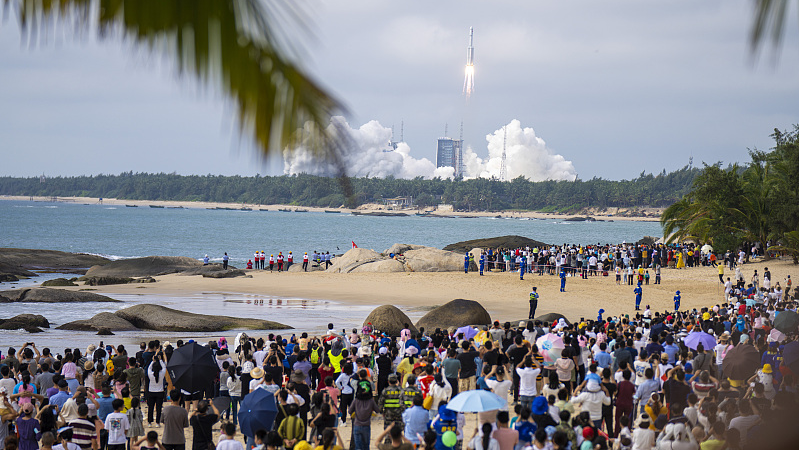
Tianzhou-5 cargo spacecraft blasts off at Wenchang Spacecraft Launch Site in south China's Hainan Province, November 12, 2022. /CFP
Tianzhou-5 cargo spacecraft blasts off at Wenchang Spacecraft Launch Site in south China's Hainan Province, November 12, 2022. /CFP
China is set to push more aerospace endeavors after the construction of its space station, a key milestone at the end of the three-year COVID-19 pandemic that shows the nation is ready to refocus on growth.
The nation plans to launch more than 200 spacecraft with nearly 70 space missions this year, according to a blue paper concluding that last year's achievement and outlining this year's plan published by the China Aerospace Science and Technology Corporation (CASC). The record-breaking plan could move China to further strengthen its capability in space technology innovation and space exploration.
The ambitious plan indicates China's space projects enters a post-COVID-19 era. The pandemic brought hiccups to some programs and the threat of the virus hampered the communications process and supply chain, Wang Xiaojun, head of the China Academy of Launch Vehicle Technology (CALT) told an international forum in 2021.
With the threat of COVID-19 in the rearview mirror, Chinese scientists also plan to launch two manned missions and one or two cargo spacecraft every year to the China Space Station (CSS), according to China Manned Space Agency on Wednesday. After its construction completed in the end of 2022, the space station entered the phase of application and development this year, which is expected to last more than a decade. The Long March carrier rocket series is also expected to exceed 500 launches cumulatively this year since they began service in 1970.
China's space development leapfrogged in the past decade with the successful assembly of every new spacecraft, said Jiang Xu, who works at the assembly and environmental engineering department of China Academy of Space Technology. "Behind each spacecraft, it's a slew of key technological breakthroughs and more reliable and advanced homegrown components."
CSS in first year operation
Embracing its first-year operation after full construction, the space station will witness multiple missions taking place.
In May, the Tianzhou-6 cargo spacecraft will be launched to dock at the rear port of the core module of CSS, which forms into a combination of three modules and two spacecraft. The mission will replenish the daily supply, component supply for maintenance, mission payload samples and propellant.
In the same month, the Shenzhou-16 manned mission will be carried out. The spacecraft will dock with the radial port of the core module and the assembly will be a combination of three modules and three spacecraft.
In October, the Shenzhou-17 manned mission is scheduled to blast off and dock at the front port of the core module.
Shenzhou-15 and 16 crews will have multiple spacewalks this year. For the first time, "We will see man and cargo go extravehicular together at the same time," said Jing Zheng, deputy chief commander of CSS general system in an interview with CGTN.
In addition, the two robotic arms attached to the space station will help support payload installation for the first time.
The space station system will not only support the assembly, but also support the ground support system containing a digital CSS and expansion plans as well, according to Jing.
Lunar mission and more deep space effort
China plans to push forward the fourth phase of its lunar exploration project at full throttle including the Chang'e-6, Chang'e-7 and Chang'e-8 missions, according to Wu Weiren, chief designer of China's Lunar Exploration Program. A basic international lunar research station is expected to take shape after the missions.
The blue paper shows China will continue its research and production of new models including the Chang'e-7 and Tianwen-2.
China's heavy rocket development is in the progress too. According to Gu Mingkun, deputy chief of the overall design department at the China Academy of Launch Vehicle Technology, "The heavy rocket project could be approved this year" as key technology research has been completed.
Heavy rockets can carry out diverse missions including high-orbit missions which require powerful thrust, a necessity for large-scale deep space exploration such as construction of the lunar research station, lunar resource development, the construction of the Mars Research Station and manned Mars exploration.
Commercial services
The BeiDou Navigation Satellite System, a global satellite navigation system independently built and operated by China, will strengthen its application in aerospace industry, expanding its value-added services in sectors such as energy and emergency.
Three backup satellites will be deployed in the space to further enhance the reliability of the BeiDou-3 Navigation Satellite System this year. The construction of a new-generation commercial remote-sensing satellite system will be accelerated.
More satellites such as the FY-3F and FY-3G, environmental satellite, new generation observation satellite for ocean color and high-earth-orbit satellite, among others, are on this year's list for launch, expanding its serves for multiple use and a wider public.
In addition, the CASC will boost its commercial launch services, carrying out an array of commercial satellite launches.